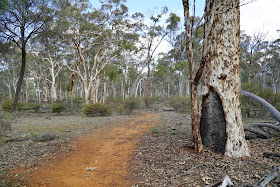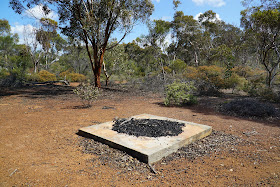An excellent loop walk in Dryandra Woodlands National Park, the Ochre Trail explore both the natural features and Aboriginal heritage of the area. Starting through lovely Wandoo forest, the trail rises up the laterite breakaway for lovely walking along the ridge. Passing the old fire lookout tower site and an ochre pit as clear points of interest, this is one of the best trails in the Dryandra Woodlands area
Distance: 5 km (loop)
Gradient: Fairly even and easy, with minor ascents and descents along the way
Quality of Path: Clear and easy to follow path - mainly purpose built walk trail with a section along a vehicle track
Quality of Signage: Well signed over its entire length
Experience Required: No Previous Bushwalking Experience Required
Time: <1.5 Hours
Steps: Some steps down from the breakaway
Best Time to Visit: Late Winter-Late Spring
Entry Fee: No
Getting There: The trail starts along Tomingley Rd. From York-Williams Rd head east on Tomingley Rd for 6.7 kilometres. The car park and trailhead are on the south side of the roadEntry Fee: No
Having initially set out to Dryandra Woodlands to do the 10 kilometre Lol Gray Walk Trail, my last minute decision to do the the short Kawana Walk instead had me wanting a little bit more of my time in the area. Having already completed the Woylie Walk in 2016, I settled on the Ochre Trail as it seemed the most interesting of the other walks in the park.
Within metres of the first trailhead, I encountered the first of several informative panels that are found all along the trail. Something that sets the Ochre Trail apart from the other trails in Dryandra Woodlands is that beyond exploring the unique woodland environment of the area, it also is an Aboriginal heritage trail that provides a fascinating insight into local Noongar culture.
The initial part of the trail passes through Wandoo woodlands, with many of the trees looks quite mature. As a fan of Wandoo, I was already in good spirits and enjoying this second loop trail in Dryandra for the day.
As with the Kawana Walk, the Ochre Trail is very well marked with directional arrows and is thus an easy trail to follow. The Ochre Trail has the edge on the Kawana Walk however as it is on a single file walk trail for the vast majority of its length apart from a small stretch towards the end.
Given the signs in the park were put in place in the 1990s (based on the CALM logo), it is surprising to see that they are still readable and not overly faded, however it was not surprising to see the above sign leaning against a tree as its base had been eaten away by termites in the intervening years.
Or perhaps it had been burnt out by fire - while it looked like it had been a few years, there were signs that a fire had gone through the area in the recent past, especially in this stretch of the trail leading up to the laterite breakaway.
While not overly steep, the trail does rise up a laterite breakaway early on, and then remains high above the valley for an extended period of time. While hardly a 'mountain', the relatively inaccessible nature of the land is the reason a lot of this area is in a much more pristine state than the lowlands that have been completely cleared and made into farmland.
While initially encountering pockets of Jarrah and Marri, I was glad to see Wandoo continuing to be the main Eucalypt along this stretch of the walk.
While Wandoo had dominated the walk from the start, the wildflowers along the top of the breakaway were really fantastic. The myriad of wildflowers added lovely splashes of colour through the woodlands, and it is one of the reasons that walking in Western Australia is truly at its best during the wildflower season.
While most of the panels along the walk tend to focus on Aboriginal heritage, the trail also offers information that engages with nature.
After the Mallee fowl nest, the trails heads across towards a vehicle track crossing to a clearing that looked like a car park or campsite.
Crossing the road, it became clear that the clearing wasn't a car park or a campground (even if charcoal did suggest it is used as an informal campsite by visitors). This is the site of the old fire lookout tower in the area, and the tower foundations and the anchor points for guy-wires that held the structure up are still visible. While I'm sure the tower had probably fallen into disrepair, I always wish that more of these fire towers had been given the Mt Wells treatment of being refurbished and made walker friendly as it would be cool to have a lookout at this high point of the park.
From the fire tower site, the walk continues along single file walking track through more lovely Wandoo forest.
A short distance from the tower site is the best part of the Ochre Trail. Running right along the edge of the breakaway, this stretch features outstanding views down the breakaway of Wandoo and the farmland beyond. Meanwhile, the breakaway edge is filled with laterite rock formations and colourful wildflower-filled heath. The result is easily my favourite stretch of walking in Dryandra Woodlands so far.
More signage provides information about how these laterite breakaways were formed. While I knew that laterite was formed from iron and aluminium ores (hence the mining in the Darling Scarp), I hadn't realised that laterite was formed from the reconstituted remains of ancient granites but is unsurprising considering how both granite and laterite figure so strongly in the Darling Scarp.
After an enjoyable stretch along the rim, the trail heads across through the more sparse middle flat top of the breakaway before heading to the trail's big descent.
Western Australia is fairly risk averse and thus there are a plethora of risk signs throughout our national parks. Most are fairly common and repeatable, but it is always amusing to see some of the more unique ones like the 'Steep and Slippery Trail Risk' located here in the park. Gotta catch 'em all!
Hilariously, the slip risk section is only short before leading to some well formed steps. While there is definitely a somewhat slippery stretch, it isn't very long and there are much more slippery sections of trails in other parts of the state, so it seemed weird that this spot in particular was singled out as significantly risky.
Down at the bottom of the descent, the trail skirts the bottom edge of the breakaway's slope. At this point the Wandoo woodlands give way to Brown Mallet - a thinner but equally beautiful smooth barked Eucalypt that was once used for its tannins, and is still used today for tool handles.
Before leaving the breakaway, the trail passes by another fascinating landmark - an ochre pit.
Used for painting by the Noongar people, the signage provides another insight into local Aboriginal culture and the techniques they used used to sift out the ochre.
From the ochre pit, the trail heads through Wandoo-dominated flats that provide pleasant if somewhat unremarkable walking.
The flat walking through Wandoo ends at the edge of the national park, with Windows background green grass. While unnatural, I feel like seeing this from the trail is a good contrast as it shows how valuable the Dryandra Woodlands are given how much has been cleared over the years and converted to farmland.
From the farmland view, the walk follows the boundary perimeter vehicle track fire trail as it heads north towards Tomingley Dr.
Heading down the road I could hear the sound of cars ahead, however before reaching Tomingley Dr itself, the trail turns off the vehicle track and follows the last leg of single file walk trail back to the car park and the end of the loop.
































Nice article. Had been there - only yesterday.
ReplyDelete